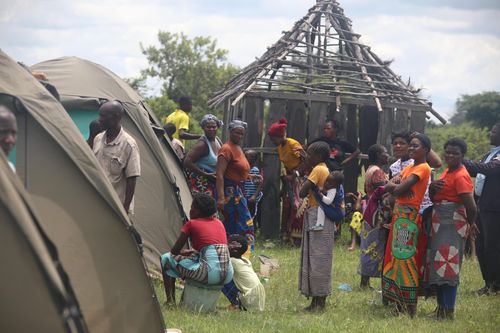Pit latrines have emptied, human excrement has engulfed homes, water wells and the environment are contaminated as Namwala town reels from a looming public health disaster.
With flash floods pounding Namwala, the local authority is blaming residents.
They are the cause of the floods that have blocked natural waterways due to unplanned structures built on traditional land, adjacent to the town’s central business district, says Namwala town council.
Blame game
Namwala mayor Abel Moonga, told MakanDay that areas most hit lie near the airstrip and in Chikwando, were new settlements have recently sprung up. Most houses and other valuables were submerged in water.

Moonga said the plots in these areas are issued by traditional leaders, who are custodians of the land and the council did not have authority to supervise building works.
That was until 2015, when legislation for Integrated Development Planning (IDP) was introduced after it was passed into law by parliament.
The mandate of the IDP is drawn from the Urban and Regional Planning Act No. 3 of 2015. The Act gives municipalities power to include traditional land in their development planning.
Moonga said affected residents ignored the council’s advice not to build in the water passage.
He warned that the council, using funds from the Constituency Development Fund (CDF), plans to demolish houses that were built in the water corridor to pave way for the construction of the drainage.
“We have asked the planner to see if we can make drainages and culverts, not just on the affected area but in the whole town,” Moonga said.
“We have established a camp in Chief Nalubamba’s area called Mpombo resettlement. That is where some families that were evacuated last year from Namalyo are accommodated.”
He also disclosed that the council has secured land in Chinyemu in Chief Muchila’s area where 400 plots will be allocated to residents.
Unplanned settlements
A MakanDay journalist who was in Namwala observed that the affected areas, and the entire town, has no drainage system. The only available single culvert, with Road Development Agency (RDA) branding, is old, small and can hardly hold off a huge volume of water.
Part of the district sits on the Kafue flats, which after the Barotse plain, is the second biggest floodplain in Zambia. The district has the highest concentration of traditionally-owned cattle in Zambia.
Namwala pastoralists depend heavily on the flooding of the Kafue River for their livestock to survive long dry seasons.
However, the floods in Namwala occur in specific lower-lying areas and authorities say this is the first time that the central business district has been flooded.
District Agriculture Officer Sokuluku Daka, told MakanDay that 44 homes completely collapsed and over 120 chickens were lost in the flood.
He explained that, although Namwala town is elevated at 1,200 metres above sea level, it comprises the Kafue main river channel, lagoons and swampy areas on an elevation of 1,056 metres.
He said the Kafue flats are very critical as they support hydro-power generation at Itezhi-tezhi dam, tourism, fishing, farming and livestock
“The farming and cattle grazing livelihoods that characterise Namwala are dependent on a rich ecosystem nourished by the seasonal flooding, flow and flux of the Kafue River,” Daka explained.
“The farming and cattle grazing livelihoods that characterise Namwala are dependent on a rich ecosystem nourished by the seasonal flooding, flow and flux of the Kafue River,” Daka explained. “The farming and cattle grazing livelihoods that characterise Namwala are dependent on a rich ecosystem nourished by the seasonal flooding, flow and flux of the Kafue River,” Daka explained.
“Don’t forget that floods are caused by climate change. Flats’ seasonal flooding is now often unpredictable in its timing and duration. Grazing and cropping patterns have changed dramatically and flood-dependent livelihoods are threatened.”
“Don’t forget that floods are caused by climate change. Flats’ seasonal flooding is now often unpredictable in its timing and duration. Grazing and cropping patterns have changed dramatically and flood-dependent livelihoods are threatened.”
Red Cross
The Red Cross has confirmed that human activities have greatly contributed to the flash floods in which many families lost valuable property.
Local Red Cross chairman Judson Moyo, said residents built on a water corridor, where water from higher ground flows into the Namwala River that feeds the Kafue River.
“We are just praying that waste from pit latrines would be washed away when the flood waters rescind, otherwise that will potentially cause a public health problem.”
Moyo said the floods also weakened some structures and destroyed food crops.
DMMU response
?Disaster Management Unit (DMMU) national coordinator Dr Gabriel Pollen, and his team, was in the area to inspect the extent of the damage caused by the floods and hand out relief food to victims.

The items given to victims include, mealie meal, cooking oil, sugar, salt and chlorine, but missing from the donation was bottled water.
While residents depend on water from the Southern Water and Sewerage Company (SWASCO), they however complained that the water they drink has a salty taste.
But the claims were dismissed by the company. “Our boreholes in Namwala town do not have salty water,” said Liversage Mulinda, company public relations manager. “Unless people are referring to personal or private boreholes where we have no control as per our mandate as a utility company. Even from our profile of complaints from our customers where we supply water, we do not have any such complaint.”
On January 9, Namwala was hit by a heavy downpour, which authorities say has never been experienced in this part of the country.
The heavy rain which started from around mid-morning to late evening, is said to have damaged crops, houses and brick wall perimeters.

Discover more from MAKANDAY
Subscribe to get the latest posts sent to your email.



